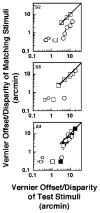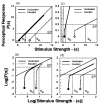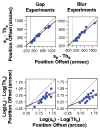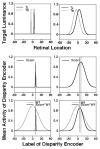Relationship between threshold and suprathreshold perception of position and stereoscopic depth
- PMID: 19340259
- PMCID: PMC2829985
- DOI: 10.1364/josaa.26.000847
Relationship between threshold and suprathreshold perception of position and stereoscopic depth
Abstract
We seek to determine the relationship between threshold and suprathreshold perception for position offset and stereoscopic depth perception under conditions that elevate their respective thresholds. Two threshold-elevating conditions were used: (1) increasing the interline gap and (2) dioptric blur. Although increasing the interline gap increases position (Vernier) offset and stereoscopic disparity thresholds substantially, the perception of suprathreshold position offset and stereoscopic depth remains unchanged. Perception of suprathreshold position offset also remains unchanged when the Vernier threshold is elevated by dioptric blur. We show that such normalization of suprathreshold position offset can be attributed to the topographical-map-based encoding of position. On the other hand, dioptric blur increases the stereoscopic disparity thresholds and reduces the perceived suprathreshold stereoscopic depth, which can be accounted for by a disparity-computation model in which the activities of absolute disparity encoders are multiplied by a Gaussian weighting function that is centered on the horopter. Overall, the statement "equal suprathreshold perception occurs in threshold-elevated and unelevated conditions when the stimuli are equally above their corresponding thresholds" describes the results better than the statement "suprathreshold stimuli are perceived as equal when they are equal multiples of their respective threshold values."
Figures









Similar articles
-
Perceived suprathreshold depth under conditions that elevate the stereothreshold.Optom Vis Sci. 2012 Dec;89(12):1768-73. doi: 10.1097/OPX.0b013e3182772dff. Optom Vis Sci. 2012. PMID: 23160439 Free PMC article.
-
The effects of interocular correlation and contrast on stereoscopic depth magnitude estimation.Optom Vis Sci. 2008 Mar;85(3):164-73. doi: 10.1097/OPX.0b013e3181643e65. Optom Vis Sci. 2008. PMID: 18317331
-
Stereopsis, spatial frequency and retinal eccentricity.Vision Res. 1995 Aug;35(16):2329-37. doi: 10.1016/0042-6989(94)00307-8. Vision Res. 1995. PMID: 7571468
-
Vertical disparity, egocentric distance and stereoscopic depth constancy: a new interpretation.Proc R Soc Lond B Biol Sci. 1989 Sep 22;237(1289):445-69. doi: 10.1098/rspb.1989.0059. Proc R Soc Lond B Biol Sci. 1989. PMID: 2573901 Review.
-
Mechanisms of stereopsis in monkey visual cortex.Cereb Cortex. 1995 May-Jun;5(3):193-204. doi: 10.1093/cercor/5.3.193. Cereb Cortex. 1995. PMID: 7613075 Review.
Cited by
-
The absolute disparity anomaly and the mechanism of relative disparities.J Vis. 2016 Jun 1;16(8):2. doi: 10.1167/16.8.2. J Vis. 2016. PMID: 27248566 Free PMC article.
-
Perceived suprathreshold depth under conditions that elevate the stereothreshold.Optom Vis Sci. 2012 Dec;89(12):1768-73. doi: 10.1097/OPX.0b013e3182772dff. Optom Vis Sci. 2012. PMID: 23160439 Free PMC article.
-
Selecting the Most Relevant Brain Regions to Classify Children with Developmental Dyslexia and Typical Readers by Using Complex Magnocellular Stimuli and Multiple Kernel Learning.Brain Sci. 2021 May 28;11(6):722. doi: 10.3390/brainsci11060722. Brain Sci. 2021. PMID: 34071649 Free PMC article.
References
-
- Fechner GT. Elemente der Psychophysik. Breitkopf and Hartel; 1860.
-
- Green DM, Swets JA. Signal Detection Theory and Psychophysics. Krieger; 1974.
-
- Swanson WH, Wilson HR, Giese SC. Contrast matching data predicted from contrast increment thresholds. Vision Res. 1984;24:63–75. - PubMed
-
- Georgeson MA. Temporal properties of spatial contrast vision. Vision Res. 1987;27:765–780. - PubMed
Publication types
MeSH terms
Grants and funding
LinkOut - more resources
Full Text Sources
Miscellaneous

